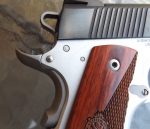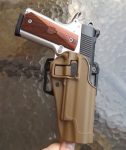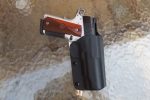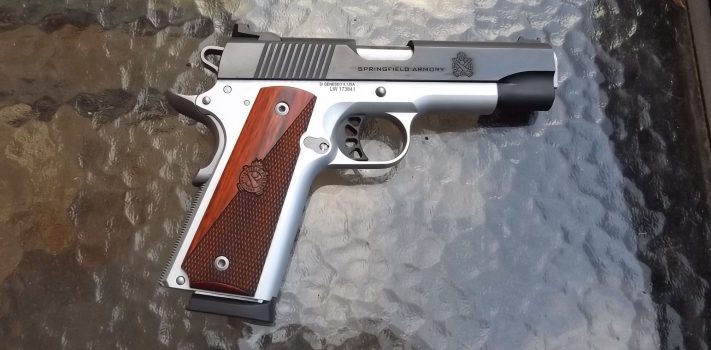Having spent 35-years in the martial arts, I knew what the word “Ronin” meant, but many people don’t. The short story is that a Ronin is an out of work Samurai – one who has no master to serve. I can understand Springfield Armory selecting this term for their newest 1911, and I’m only going to cover their newest model, and it is a lightweight model, with a 4.25-inch barrel. (Commonly called “Commander” size.) To put it bluntly, the Springfield Ronin, is in search of a brave person, a man (or woman) of honor, and this Ronin wants to serve its new Master in the role of a self-defense handgun.
I don’t normally buy into any advertising hype on any product, however, this is straight from the Springfield web site, and I agree with it:
“Featuring an unyielding commitment to strength, reliability and quality, the Ronin Operator 4.25-inch combines rugged durability, with lightweight and ease of carry. The .45 ACP pistol features a forged alloy frame for an overall weight of around 30-ounces. The short 4.25-inch barrel matches up with a traditional barrel bushing system, and a forged hot salt blued slide and stainless steel hammer-forged barrel ensure a lifetime of service.”
That’s quite a mouthful to say. But I agree with everything that was said about this outstanding 1911 from Springfield.
I’ve probably owned no less than a hundred 1911s over the years, from the full-sized Government Model, to the smaller Officer’s style, and everything in between, and from dozens of 1911 makers, I’ve owned some really expensive 1911, including a Wilson Combat, and from Les Baer. I used to build 1911s when I was younger, too. So, I’m more than a little intimate with the details of a 1911 method of operation. Wish I still owned many of those 1911s, however, I’m a habitual gun trader – because I simply can’t afford to own all the firearms I’d like to own.
Ronin Specifications
 Let’s look at the specifications on the new Ronin. As already mentioned, the frame is forged – not cast – Aluminum, and the slide is forged carbon steel, and it has a deep blue hot salt bath finish – something you rarely see these days on firearms. The frame has a grayish/silver Cerakote finish on it, instead of chrome, and the Cerakote will outlast a chrome finish by years, it’s tough stuff. The front sight is a red fiber optic, and the rear sight has two white dots – and you can pick-up that front sight fast. Of course, some will opt to install night sights on their Ronin – and I have no problem with that.
Let’s look at the specifications on the new Ronin. As already mentioned, the frame is forged – not cast – Aluminum, and the slide is forged carbon steel, and it has a deep blue hot salt bath finish – something you rarely see these days on firearms. The frame has a grayish/silver Cerakote finish on it, instead of chrome, and the Cerakote will outlast a chrome finish by years, it’s tough stuff. The front sight is a red fiber optic, and the rear sight has two white dots – and you can pick-up that front sight fast. Of course, some will opt to install night sights on their Ronin – and I have no problem with that.
The recoil system is a traditional GI type, and that means, you don’t need a special tool or bent paper clip into order to disassemble the Ronin – outstanding! The grips are laminate, and are thin grips. I was going to swap out the grip bushings for the full-length size, and install a pair of my Code Zero 191 grips from Mil-Tac.com but these grips that came on the gun are so attractive and the gun feels great in my hand, so I left these on. Half the grip panels are checkered and the other half are smooth – I like it – a lot. And, we have the Springfield Armory crossed cannons embossed into the grip panels.
 The hammer is stainless steel, and is of the combat-style, easy to thumb back if you want to, and we have an extended beavertail grip safety, and the mainspring housing is checkered, however it is made out of polymer. I have to admit that when 1911s first started appearing with polymer mainspring housings, I didn’t think they would hold up – but they do! There is a regular-sized magazine release button, and it is all you need, because the thin grips allow easy access to the mag release. However, this is one of the few things I swapped out – I installed a slightly extended mag release.
The hammer is stainless steel, and is of the combat-style, easy to thumb back if you want to, and we have an extended beavertail grip safety, and the mainspring housing is checkered, however it is made out of polymer. I have to admit that when 1911s first started appearing with polymer mainspring housings, I didn’t think they would hold up – but they do! There is a regular-sized magazine release button, and it is all you need, because the thin grips allow easy access to the mag release. However, this is one of the few things I swapped out – I installed a slightly extended mag release.
 The trigger is what Springfield refers to as a Gen 2 – and it is made out of G-10 material, and it is an extended long trigger, but it is not adjustable, and you don’t need to adjust it for overtravel at all. Speaking of the trigger, on my Ronin sample, it breaks cleanly at 4.25-pounds – every single time. The face of the trigger is grooved, too. I did add some skateboard friction tape to the front strap on the frame – for a more secure grip on the gun in all weather conditions. The slide has rear, angled serrations, and it adds to the beauty of this pistol. There is a single-side safety on the left side, and that’s all I need, I used to demand ambidextrous safeties on 1911s, but no longer. It is easy to reach the slide stop/release as well. The magazine well is slightly beveled to help during a speed reload. Each Ronin comes with one 8-round magazine – wish it came with two – but for us lovers of the 1911, we always have plenty of spare magazines around.
The trigger is what Springfield refers to as a Gen 2 – and it is made out of G-10 material, and it is an extended long trigger, but it is not adjustable, and you don’t need to adjust it for overtravel at all. Speaking of the trigger, on my Ronin sample, it breaks cleanly at 4.25-pounds – every single time. The face of the trigger is grooved, too. I did add some skateboard friction tape to the front strap on the frame – for a more secure grip on the gun in all weather conditions. The slide has rear, angled serrations, and it adds to the beauty of this pistol. There is a single-side safety on the left side, and that’s all I need, I used to demand ambidextrous safeties on 1911s, but no longer. It is easy to reach the slide stop/release as well. The magazine well is slightly beveled to help during a speed reload. Each Ronin comes with one 8-round magazine – wish it came with two – but for us lovers of the 1911, we always have plenty of spare magazines around.
 As we already mentioned, the barrel bushing is of the GI type, easy to get the gun apart for a cleaning. And, it is stainless steel, and that contrasts nicely with the blued slide – the barrel is stainless steel and match-grade, and fitted perfectly – no discernable play between the slide/barrel/frame. It was expertly fitted by the gunsmiths at Springfield. When one looks at the Ronin, at least in my case, being an “old timer” it immediately brings back memories of some of the custom 1911s from the 1960s. Many of those 1911s had a deeply blued slide, with a frame that was hard chrome-plated – very nice looking pistols, and I always longed for one of those custom 1911s, but could never afford them. Even when I was gunsmithing my own 1911s, I never had one look as good as this Ronin does – ever!
As we already mentioned, the barrel bushing is of the GI type, easy to get the gun apart for a cleaning. And, it is stainless steel, and that contrasts nicely with the blued slide – the barrel is stainless steel and match-grade, and fitted perfectly – no discernable play between the slide/barrel/frame. It was expertly fitted by the gunsmiths at Springfield. When one looks at the Ronin, at least in my case, being an “old timer” it immediately brings back memories of some of the custom 1911s from the 1960s. Many of those 1911s had a deeply blued slide, with a frame that was hard chrome-plated – very nice looking pistols, and I always longed for one of those custom 1911s, but could never afford them. Even when I was gunsmithing my own 1911s, I never had one look as good as this Ronin does – ever!
The Ronin is one handsome 1911, and being a lightweight version really makes it all that much better in my eyes. I can shoot a Commander-style 1911 faster and more accurately than any other version of a 1911 – in any size or weight range. So, for me, the Ronin is a first-class 1911 in every respect. But can it shoot? You bet it can.
My Tests
 From Black Hills Ammunition I had the following ammo on-hand to run through this pistol for the article. I had their 135-gr HoneyBadger, 200-gr Lead Semi Wadcutter, 230-gr FMJ, 230-gr JHP, 230-gr JHP +P and their Barnes Tac-XP +P. So I put the Ronin to the test, and one of the best ways to check how well a 1911 will function is to load up the magazine with a variety of ammo styles at the same time. If anything will make a 1911 stutter, it is different types of ammo in the same magazine. I ran mag after mag through the Ronin, with the above ammo types, and the gun never missed a beat or hesitated at all. I already mentioned that the sights, with the red fiber optic front sight, were fast and easy to pick-up, and that made my shooting all that much better and more fun.
From Black Hills Ammunition I had the following ammo on-hand to run through this pistol for the article. I had their 135-gr HoneyBadger, 200-gr Lead Semi Wadcutter, 230-gr FMJ, 230-gr JHP, 230-gr JHP +P and their Barnes Tac-XP +P. So I put the Ronin to the test, and one of the best ways to check how well a 1911 will function is to load up the magazine with a variety of ammo styles at the same time. If anything will make a 1911 stutter, it is different types of ammo in the same magazine. I ran mag after mag through the Ronin, with the above ammo types, and the gun never missed a beat or hesitated at all. I already mentioned that the sights, with the red fiber optic front sight, were fast and easy to pick-up, and that made my shooting all that much better and more fun.
I did my accuracy testing at 25 yards, and I used a rolled-up sleeping bag that I keep in my emergency box, as a rest, over the hood of my truck. Many, not all, gun writers use a Ranson Rest for testing accuracy from firearms – I’ve never used one – and won’t. What the Ranson Rest does is lock your gun into it, and the rest is clamped onto your shooting table, and a mechanical “finger” pulls the trigger for you. Yeah, it helps show the absolute accuracy of any firearm. However, its not real-life – I prefer to have the gun in my hand and shoot it take way – and using a rolled-up sleeping bag or rolled-up jacket works just fine for my testing.
Hands down, the Ronin, is the most accurate Commander-size 1911 handgun that I’ve ever fired. That says a lot, because I’ve owned and shot a lot of handguns over the years. The overall winner in the accuracy department was the Black Hills 200-gr LSW load – no surprise there, as it is a match-grade load, used by many competitors. I gave me groups right at 2-inches, without trying too hard. Next up was the 230-gr FMJ load, another accurate load I’ve come to depend on from Black Hills, it gave me groups just under 2.5-inches…the other load, gave me groups right at 2.5-inches without much work.
I really like the 135-gr HoneyBadger load for self-defense, and it hovered slightly above 2.5-inches – can’t ask for better than that. Plus, the recoil factor – just not there because of the light-weight bullet. Oh sure, the gun “kicks” a bit, but not nearly as much as you think it would with the HoneyBadger load. I know the Ronin is capable of even better accuracy than I was getting, but I limited myself on the amount of ammo I was using up, because of the ammo drought we are currently in. I only fired a little less than 300 rounds during my testing.
 I carried the Ronin for just a week – many times, I like to carry a gun I’m testing for a couple weeks if possible, however I’m backed-up on gun articles and need to get to them. I carried the Ronin in a Craft Holsters Kydex holster, and it rode high and tight to my right side, however, not too high, and this holster has no suicide strap, the gun is held in the holster due to the great friction fit that Craft Holsters does. There is also a raised part on the top portion of the holster so the gun doesn’t rub against your side – a nice touch.
I carried the Ronin for just a week – many times, I like to carry a gun I’m testing for a couple weeks if possible, however I’m backed-up on gun articles and need to get to them. I carried the Ronin in a Craft Holsters Kydex holster, and it rode high and tight to my right side, however, not too high, and this holster has no suicide strap, the gun is held in the holster due to the great friction fit that Craft Holsters does. There is also a raised part on the top portion of the holster so the gun doesn’t rub against your side – a nice touch.
I couldn’t find anything to fault with the Ronin – and I only made two changes, and one was the slightly extended mag release, and the other was the friction tape on the front strap of the frame – and honestly, I didn’t need to made those changes – the gun is good to go for duty, self-defense or target practice, right out of the box.
Now, for the good news: Full-retail is only $849 – and that is one big deal if you ask me – I would have expected a gun of this quality to cost at least $1,250. I’ve owned several of the Springfield TRP 1911s, but none were as well-fitted or shot as well as this Ronin did for me. This Ronin, has found a new master, and it will serve me well for a lifetime. It’s not going back to Springfield Armory – I’ve sent them a check for my sample.











I’ve seen the Springfield ” Ronin “, but never paid any attention to it . Why, because it was another 1911, but finding out that it has a traditional G.I. bushing caught my attention. I now have a springfield range officer compact 9 ( ROC 9 ), it’s a half inch shorter in length and height and lighter in weight than my .45 colt commander, it’s a delight to shoot and a delight to carry, but I need a paper clip ( I mislaid the little itty bitty wrench for it ) to disassemble it for cleaning and it has the bull barrel ( no bushing ). As you probably can tell from what I’ve said, you would be right, Uncle Sam did or tried to teach me how to shoot a G.I. .45 many, many yrs ago ( and yes I could hit the broad side of the barn with a .45, as long as I was in the barn ). I think maybe I’ll look into the Ronin out of curiosity.
Springfield Armory does a fine job on their 1911 variants. The Ronin caught my eye as it’s also produced in 10mm full size, and 9mm full size plus a Commander variant with a 4.5” barrel and 30 oz weight. Pricing seems to be very attractive as well. Plus, 8-10 round magazines might be a good option in states that are at risk of enacting new laws on magazine restrictions. The Ronin fits the bill on that front too.
The new 1911s work just fine. But anyone with an older War Horse, might need some information.
American Rifleman on the Internet. Tuning the 1911. by NRA Staff – Sunday, July 15, 2012 .
“There should be a gap of about 0.030 inches between the bottom edge of the barrel throat and the top of the feed ramp in the frame.”
One quote on this link with pictures about the quote. [I’ve read where this ‘gap’ needs to be checked on older 1911s. Especially, the old War Horses.]
American Rifleman on the Internet. Tuning the M1911 for Reliability. by Stanton L. Wormley, Jr. – Thursday, June 9, 2011.
[There’s a lot of information in this American Rifleman article. Might be worth a read for owners of older 1911 War Horses [Even if, the 1911 is functionally perfectly right now].